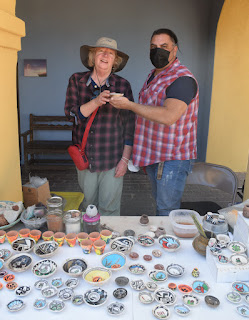On Wednesday, after a little birdwatching, we left the campground around 10 am. We drove to Nogales, where we got propane at Tractor Supply, and continued north to Pilot, where we bought gas. We followed the directions to our campground; there were a lot of turns. The campground, Sunflower Camp, is as funky as we had expected, with the owner living in a geodesic dome, and the laundry a single washer and dryer, with an honor pay box. After getting set up, we drove to town, and had lunch at Shelly's, where there was a cowboy with a guitar singing. We then started visiting the art and craft stores. Some were more fine art, some were imports from Mexico, and many were mixed. Sandi bought at a couple of stores, including Mexican pottery from the Country Shop, and a kind of tile from Cobalt Fine Arts Gallery. We visited around twelve stores, perhaps visiting one third of the many shops. I was looking at the kinetic wind art, thinking about making a piece of my own. We shopped at the Tubac Market, and headed back to camp for dinner.
On Thursday, Sandi had a couple of business calls; I dropped her off at the library so that she had a good internet connection for a zoom call. After that we went to the Presidio at Tubac, where we again saw “Pixie”, who we spoke to at the Cobalt gallery. It was worth the time to see the complicated history of Tubac. The history of Tubac goes back to around 1750; De Anza left from Tubac when he went cross country to establish San Francisco. Apache raids were an ongoing problem. We had dinner at Wisdom restaurant in Tumacaccori. We came back to try to bird near the Santa Cruz River, but there were almost no birds to see or even hear. Sandi did laundry at the campground in the evening.
Friday, we headed for the Desert Museum in Tucson, where we saw more different cactus plants than we knew existed. We also saw Mexican gray wolves. We had lunch there, and enjoyed just walking around the grounds. We also learned that Saguaro cactus grow between 1000 and 4000 ft elevation, and do not like the bottom of valleys, as it can get too cold at night. There are four kinds of Desert in the US, the Sonoran, the Great Basin, the Mojave, and the Chihuahuan. The Saguaro cactus is the mark of the Sonoran desert. We also saw their Javelina, which we had not seen before. All in all, a very worthwhile visit.
We continued on to the adjacent Saguaro National Park, where we did some hiking and saw more saguaros than we could count. We also hiked to some petroglyphs that were dated by style to the Hohokam culture of about 1000 AD. In most cases, petroglyphs are difficult to date, let alone interpret. We got back to our campground after dark.
 |
| Acorn Woodpecker |
Saturday, we headed for Madera Canyon. We stopped at Santa Rita Lodge, where there is a bird watching area with many feeders. The Mexican Jays and the lesser goldfinches were there in force. We drove to the top, decided that the trails there were too steep, and drove down to the bottom, where we hiked next to the creek. There was another group with an birding instructor; she managed to see interesting birds in the trees, but we did not get a clear look at many of them. We came back to the lodge, where we were amused by a dozen turkeys, who had learned to jump up and bump the feeders to get food to drop on the ground. We also were able to see a pair of Hepatic Tanagers, a brightly colored bird which is relatively rare. We had a picnic lunch in the canyon, and then headed to the San Xavier del Bac mission, which was founded in 1692 by Father Kino. The current church was built in the late 1700s, and is the oldest European structure in Arizona. It is still an active parish, serving the O'odham tribe. .We finished the day visiting a few more shops in Tubac.
 |
| San Xavier de Bac |
Sunday, we started at the cemetery, where we again saw many homemade monuments. We were surprised to see many graves just covered with a pile of rock, but we learned later that was the custom of the O'odham people.
Then we went to Tumacacori, another of the missions founded by Father Kino. This is a National Historical Park, declared so by Teddy Roosevelt. The buildings are partially restored; the grounds include an orchard of heirloom trees, a lime kiln, and a cemetery. The village was abandoned in the 1700 due to Apache raids. We chatted with Vincente, a potter connected to Mata Ortiz, who was at the park demonstrating; Sandi bought a couple of small dishes.







This is such an interesting blog, Richard and Sandy! I especially enjoyed the pictures that were shared with the readers. Looking great out there. When you wrote of the Indian tribes, I know of them through The Casa in Phoenix. The assembly there contributes to the needs of their communities. Seems you had pretty fine weather and had a beautiful experience. !O! ~O~ !"!
ReplyDeleteThanks.
Delete